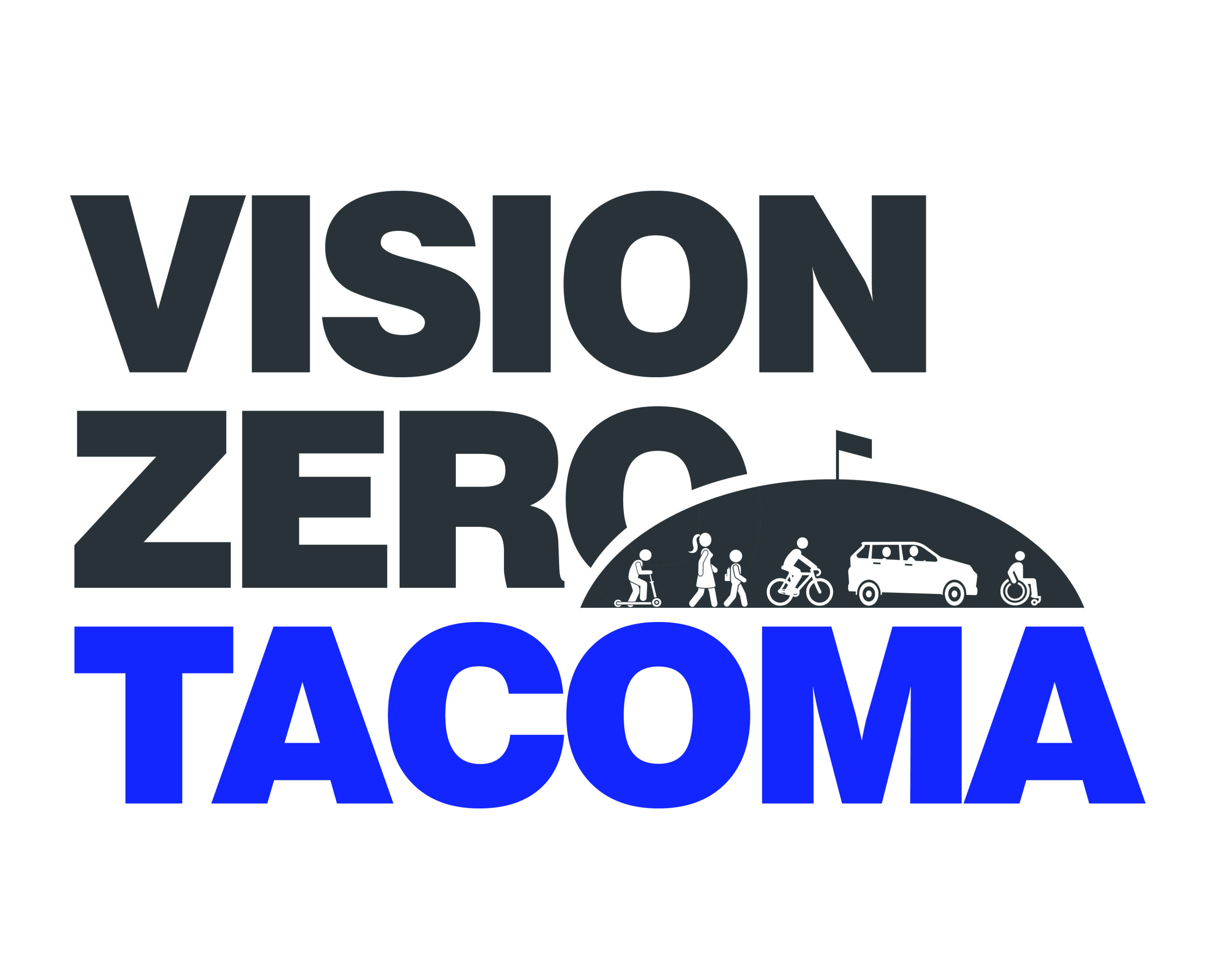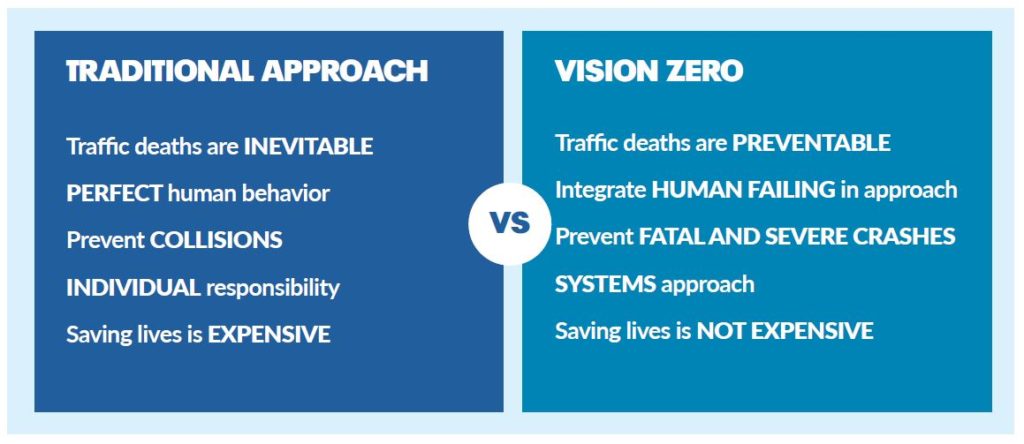
Vision Zero
 In 2020, the Tacoma City Council passed Resolution 40559, committing to Vision Zero and the goal of eliminating traffic fatalities and serious injuries in the City of Tacoma by 2035. Vision Zero utilizes the Safe System Approach. Unlike traditional traffic safety methods that might tolerate a certain level of risk, Vision Zero acknowledges that while human error is unavoidable, death and severe injury are not. The Safe Systems Approach involves five overlapping elements: Safer People, Safer Speeds, Safer Roads, Safer Vehicles, and Post-Crash Care. Relying on just one element alone to prevent death and serious injury is not sufficient. This approach emphasizes shared responsibility and proactive measures across all aspects of road safety—ranging from roadway design and vehicle technology to the roles of policymakers, planners and engineers, state agencies, and road users.
In 2020, the Tacoma City Council passed Resolution 40559, committing to Vision Zero and the goal of eliminating traffic fatalities and serious injuries in the City of Tacoma by 2035. Vision Zero utilizes the Safe System Approach. Unlike traditional traffic safety methods that might tolerate a certain level of risk, Vision Zero acknowledges that while human error is unavoidable, death and severe injury are not. The Safe Systems Approach involves five overlapping elements: Safer People, Safer Speeds, Safer Roads, Safer Vehicles, and Post-Crash Care. Relying on just one element alone to prevent death and serious injury is not sufficient. This approach emphasizes shared responsibility and proactive measures across all aspects of road safety—ranging from roadway design and vehicle technology to the roles of policymakers, planners and engineers, state agencies, and road users.

Vision Zero Action Plan
Tacoma’s Vision Zero Action Plan was approved in 2022. This data-driven document is used to guide Tacoma’s investment in traffic safety. The Action Plan is just the start of Tacoma’s commitment to ensure transparency and accountability and work with urgency to reduce the number of people killed or seriously injured while walking, biking, or driving in Tacoma.
Tacoma Vision Zero Action PlanUsing the Vision Zero Action Plan as a guide, we continuously explore opportunities to improve our transportation system for people driving, walking, rolling, biking, or taking transit, including:
- Designing streets that make safe behavior the default.
- Making changes to our codes and policies, such as reducing speed limits, adding automated enforcement traffic cameras in key locations, and calming traffic in our neighborhoods, that result in safer roadways for all.
- Educating drivers to be safe and respectful of all road users.
- Creating systems for evaluation as we make ongoing improvements to our shared roadways.
- Significantly increasing our investments in active transportation projects (sidewalks, crossings, bikeways) so that every transportation project is approached as an opportunity to improve safety.
Annual Progress Report
The Vision Zero Annual Progress Report provides an update on progress toward the actions outlined in the 2022 Vision Zero Action Plan, including crash analysis, progress, challenges, partnerships, and next steps. In line with the Vision Zero Action Plan Transformative Action 1.2, the report will be provided to the City Council, the Transportation Commission, and the public. Sharing the progress and insights aims to foster transparency and accountability as efforts to enhance road safety across Tacoma continue.
Data Dashboard
The City of Tacoma closely monitors the number and locations of crashes to identify trends and measure progress toward achieving zero fatal or serious injury crashes. This data, provided by the Washington State Department of Transportation (WSDOT), is updated annually, with each year’s crash data becoming available in April. The Vision Zero Data Dashboard is an interactive tool that displays some of the key crash trends and locations in Tacoma. Using data to transparently track and communicate the City’s efforts and the outcomes of these efforts is central to achieving the Vision Zero goal.
Vision Zero Data Dashboard-
Road Safety Audits (RSA) involve a collaborative team from various departments, including Public Works, Planning and Development Services, the Fire Department, Police Department, and Pierce Transit, all working together to assess and enhance road safety for all users. These audits aim to identify safety issues and opportunities for improvement, leading to actionable steps for near-term fixes and potential corridor redesigns to enhance safety. The purpose of an RSA is to answer the following questions:
- What elements of the road may present a safety concern: to what extent, to which road users, and under what circumstances?
- What opportunities exist to eliminate or mitigate identified safety concerns?
The corridors selected for RSAs are part of Tacoma’s Vision Zero High-Risk Network, identified based on crash history or potential safety concerns for people walking and biking. These corridors often have complex roadway designs or intersections that would benefit from further study to explore potential safety improvements. Additionally, they offer opportunities for collaboration with the community and alignment with other ongoing planning efforts. Funding for the RSAs came from a grant from the Washington Traffic Safety Commission (WTSC).
2024 RSAs
- South Tacoma Way (South 62nd Street to South 47th Street)
- South Yakima Avenue (South 25th Street to South 8th Street)
- South Pine Street (South 47th Street to Center Street)
2025 RSAs – Underway
- South 72nd Street (South Sheridan Avenue to A Street)
- 6th Avenue (Jackson Avenue to Pearl Street)
- South 12th Street (South Union Avenue to South Sprague Avenue)
2026 RSAs
- To be determined – Three corridors
-
In January 2023, the speed limit on Tacoma residential streets became 20 miles per hour (MPH). A residential street is located in neighborhoods mostly consisting of homes, parks, and schools. Additionally, the arterial streets in four neighborhood business districts were lowered from 30 MPH to 25 MPH: 6th Avenue, Old Town, McKinley Hill, and Lincoln. Proctor and South Tacoma neighborhood business districts are already 25 MPH.
Lowering driver speeds remains a key goal of Vision Zero efforts. Future speed limit reduction initiatives will continue to be data-driven and are likely to include physical improvements to further enhance safety.
Learn More About Tacoma’s Speed Reduction Efforts -
The actions in the Vision Zero Plan were identified based on the findings from:
Get Involved
Contact us to sign up for Vision Zero Updates.